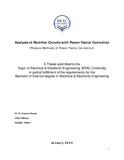| dc.contributor.advisor | Abedin, Amina Hasan | |
| dc.contributor.author | Hassan, M. M. Emran | |
| dc.contributor.author | Sultana, Afrin | |
| dc.contributor.author | Akther, Sunjida | |
| dc.date.accessioned | 2014-03-18T08:51:36Z | |
| dc.date.available | 2014-03-18T08:51:36Z | |
| dc.date.issued | 2014-01 | |
| dc.identifier.other | ID 08310024 | |
| dc.identifier.other | ID 08210001 | |
| dc.identifier.other | ID 08110046 | |
| dc.identifier.uri | http://hdl.handle.net/10361/3053 | |
| dc.description | This thesis report is submitted in partial fulfillment of the requirements for the degree of Bachelor of Science in Electronics and Communication Engineering, 2014. | en_US |
| dc.description | Cataloged from PDF version of thesis report. | |
| dc.description | Includes bibliographical references (page 41). | |
| dc.description.abstract | Power Factor, the ratio between the real power and the apparent power forms a
very essential parameter in power system. It is indicative of how effectively the real
power of the system has been utilized. With rapid development in power semiconductor
devices, the usage of power electronic systems has expanded to new and wide
application range that include residential, commercial, aerospace and many others.
Power electronic interfaces have proved to be superior. However, their non‐linear
behavior puts a question mark on their high efficiency. The current drawn by the
interfaces from the line is distorted resulting in a high Total Harmonic Distortion(THD)
and low Power Factor(PF).
Individually, a device with harmonic current does not pose much serious problem
however when used on a massive scale the utility power supply condition could be
deteriorated. Other adverse effects on the power system include increased magnitudes
of neutral currents in three‐phase systems, overheating in transformers and induction
motors etc.
Hence, there is a continuous need for power factor improvement and reduction
of line current harmonics. Development of new circuit topologies and control strategies
for Power Factor Correction (PFC) and harmonic reduction has become essential. This
project aims to develop a circuit for PFC using passive filters. | en_US |
| dc.description.statementofresponsibility | M. M. Emran Hassan | |
| dc.description.statementofresponsibility | Afrin Sultana | |
| dc.description.statementofresponsibility | Sunjida Akther | |
| dc.language.iso | en | en_US |
| dc.publisher | BRAC University | |
| dc.title | Analysis of Rectifier circuits with power factor correction | en_US |
| dc.title.alternative | Passive Methods of Power Factor Correction | en_US |
| dc.type | Thesis | en_US |
| dc.contributor.department | Department of Electrical and Electronic Engineering, BRAC University | |
| dc.description.degree | B. Electrical and Electronic Engineering | |

